- PRODUCTS
- MARKFORGED ONYX PRO
- MARKFORGED MARK TWO
- MARKFORGED X7
- MARKFORGED FX10
- MARKFORGED FX20
- MARKFORGED METAL X
- BIGREP PRO
- BIGREP STUDIO
- BIGREP ONE
- BIGREP ALTRA 280
- BIGREP IPSO 105
- BIGREP VIIO 250
- MELTIO M450
- MELTIO M600
- MELTIO ENGINE CNC INTEGRATION
- MELTIO ENGINE ROBOT INTEGRATION
- MELTIO ROBOT CELL
- PHOTOCENTRIC LC TITAN
- PHOTOCENTRIC LC MAGNA
- PHOTOCENTRIC LC OPUS
- 3D MATERIALS
- PARTS ON DEMAND
- SUPPORT
- RESOURCES
- CONTACT
- ABOUT
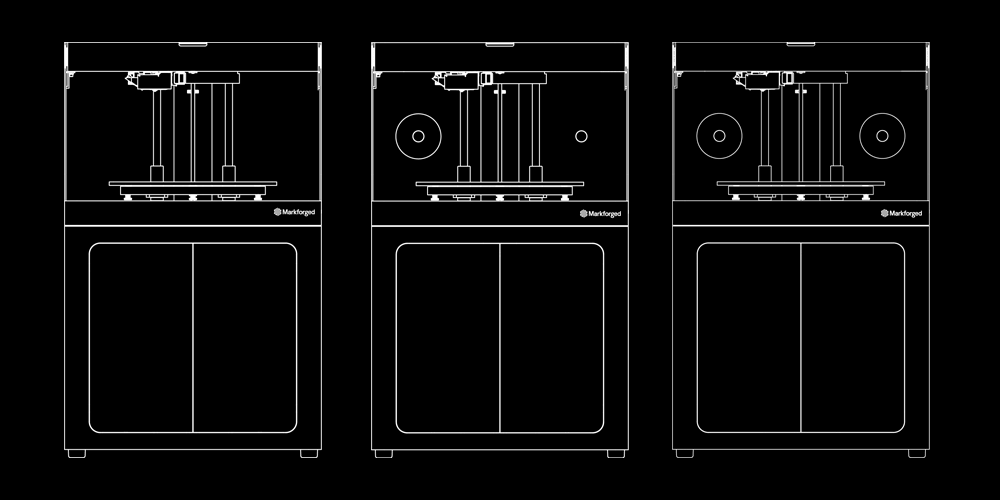
Your Complete Guide to Composite 3D Printing with Markforged
This comprehensive guide was created to provide an overview of composite 3D printing, as well as an in-depth look at the technologies, printers and materials from Markforged.
GETTING STARTED
Introduction to Composite 3D Printing
In general, the term “composites” refers to any material that is made of two or more different materials. Composites take advantage of the characteristics of the different materials included.
When used in 3D printing, composites typically consist of one plastic or nylon material that is reinforced with fibers. Composite printing allows manufacturers to build lightweight, yet strong parts due to the strength properties of the fiber materials. Fibers in 3D printing come in two formats - chopped fibers and continuous fibers.
Chopped vs. Continuous Fiber
Chopped Fiber
In chopped fiber applications, fibers are less than a millimeter long and mixed into a nylon thermoplastic. Materials are typically printed using traditional Fused Deposition Modeling (FDM) technology. The fibers will increase the stiffness of the material, but will have only a small impact on the strength. In addition, depending on the amount of fibers, the surface finish of the printed part may be impacted.
Continuous Fiber
The highest performance enhancement comes from continuous fibers which run uninterrupted through a part, distributing loads across the entire geometry of the part. Continuous fibers, therefore, have a significant impact on part strength. The most common fiber used is carbon fiber as it has the highest strength-to-weight ratio.
What is Continuous Filament Fabrication?
Continuous Filament Fabrication (CFF) is the flagship 3D printing technology from Markforged. Composite printers from Markforged that print with CFF technology use two print nozzles: one for the thermoplastic matrix and a second to lay down the fibers intact. As the fibers are added, a plastic coating around them melts so that the fibers then adhere to the matrix.
With Markforged composite 3D printers, you have a wide array of options for combining different plastics and fibers. Each specific combination gives you a different set of combined properties, allowing manufacturers to find the best combination for each application. For example, if you need a part that is extremely strong and also flame retardant, combine the Onyx FR plastic with carbon fiber. There are even combinations that are proving to be stronger and more lightweight than metal.
That is not to say, though, that composites are going to replace metal. Each fabrication method has its place in the industry. In fact, both composite and metal 3D printing applications can work together in tandem to help facilitate affordable and effective manufacturing.
Want to see it action for yourself? Contact EXBuild today for a demonstration.
Applications for Continuous Fiber 3D Printing
Additive Manufacturing with continuous fibers allows for high strength parts for every stage of the design and manufacturing process.
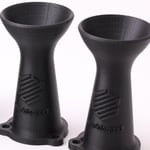
Prototyping & Testing
3D printing allows for faster iterations of initial prototypes. Using continuous fibers makes prototypes stronger and more functional to test how your parts will behave in context prior to production.

Tooling & Production
Use composite 3D printing to efficiently create strong, custom tools with more complexity. The strength of continuous fiber means these parts are ready to work and durable enough for the production floor.
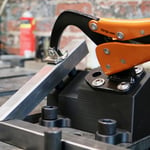
Assembly & Inspection
Supplement assembly operations with strong 3D printed parts optimized for your process and production environment. Build inspection hardware without sacrificing necessary stiffness or durability.
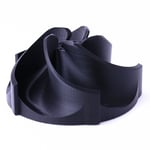
End-Use & Replacement Parts
Implement 3D printing for low-volume, functional parts to be used in final products, or to print replacement parts on-demand for the manufacturing line.
Materials for Composite 3D Printing
Markforged uses engineering-grade composite materials for 3D printed parts that are strong enough to be suitable for every stage in the manufacturing process.
Base Plastic Materials
Markforged uses a composite material called Onyx for the base thermoplastic material, which is stronger than standard ABS and nylon materials used by other printers.
Onyx
The Onyx composite is nylon mixed with chopped carbon fiber, creating a high-strength thermoplastic that features excellent heat resistance, chemical resistance and surface finish. Printed alone, it is 1.4x stronger and stiffer than ABS, but can also be reinforced with any continuous fiber material.
Onyx FR
The Onyx FR composite has similar properties to standard Onyx, but is a Blue Card certified UL94 V-0 material. This material is ideal for applications which require flame-retardant, high-strength and low-weight properties.
Onyx ESD
The Onyx ESD is an ESD-safe micro carbon fiber filled nylon composite base material with similar mechanical properties and surface finish to Markforged Onyx. It is static-dissipative and reinforced with continuous fibers to achieve up to 10x strength compared to existing ESD-safe plastics.
Reinforcement Fiber Materials
Each type of reinforcement fiber currently available from Markforged has unique properties and advantages when combined with Onyx in the Continuous Filament Fabrication printing method.
Fiberglass
Fiberglass offers high strength at an accessible price. 11x more rigid than ABS, it is perfect for jigs, fixtures, functional prototypes and some end use parts.
HSHT Fiberglass
High Strength High Temperature (HSHT) Fiberglass has more than 2x the strength of standard fiberglass and delivers the highest impact resistance and heat deflection temperatures of any Markforged fiber. This material also offers high elasticity.
Carbon Fiber
Carbon fiber has the highest strength-to-weight ratio. It is strong enough to replace machined aluminum parts at half the weight.
Kevlar
Kevlar fibers are tough, lightweight and can take a beating. They can bend further than any other fiber. With low density and high durability, this material is perfect for applications that involve significant motion or interfacing with production parts.
To learn more, see how to choose the right fiber for your application in this webinar recording from Markforged or review our Composite Materials Data Sheet.
Markforged Composite 3D Printers
Markforged offers a full line of composite printers including desktop and industrial machines, most of which use the Continuous Filament Fabrication printing technology for exceptionally strong and versatile parts.
Desktop Series
The Markforged Desktop Series combines industrial quality and affordability in an all-aluminum form that fits easily into your work space.
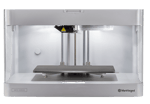
Markforged Onyx One
Designed from the ground up for quality and reliability, the Onyx One is the desktop 3D plastic printer for professionals. This 3D printer prints stiff Onyx composite parts that are 1.4x stronger than ABS.
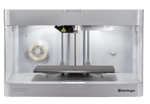
Markforged Onyx Pro
This industrial-grade desktop printer gives the perfect blend of quality and affordability. The Onyx Pro prints composite parts, combining Onyx with fiberglass reinforcement for 10x the strength of plastics.
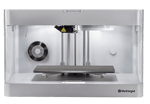
Markforged Mark Two
The Mark Two industrial desktop 3D printer is small, but produces high-performance parts. Raising the bar from the Onyx Pro, this machine introduces additional reinforcement materials for a more versatile range of parts.
Industrial Series
These industrial grade large-format printers are the go-to solution for manufacturing tooling, delivering exceptional accuracy, reliability and repeatability.
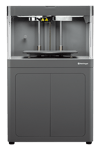
Markforged X3
The X3 is exceptionally accurate, reliable and cost-effective. The Onyx composite filament used in this industrial 3D printer creates plastic parts that are 20% stronger than ABS, are heavy duty and stand up to abuse.
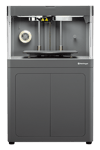
Markforged X5
The X5 is accurate, fast and affordable. It ups the ante from the X3 printer by adding fiberglass reinforcement using CFF to its composite parts, creating parts that are 20x stiffer and stronger than typical 3D printed parts.
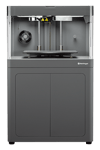
Markforged X7
The X7 takes the Markforged industrial 3D printers to the next level by introducing additional reinforcement materials for highly durable and versatile parts. Composite, continuous fiber parts printed on the X7 are stronger and lighter than aluminum, and can be ready the same day thanks to Turbo Print mode - an X7 exclusive feature.
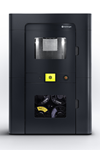
Markforged FX20
The FX20 is the biggest, fastest, smartest printer in the Markforged lineup. Engineered to deliver maximum strength, accuracy and consistency, FX20 produces mission-critical parts for the most demanding applications, from the factory floor to the skies and beyond. Replace long lead-time metals with high-temperature thermoplastics and continous fiber reinforced composites.
Tips to Be Successful with Continuous Filament Fabrication
The key to being successful with continuous fiber and getting the most out of your investment is by understanding the physics of 3D printing and identifying fiber where you need it within your parts. Below we will outline some basic tips, but once you get started, you will want to review the learning resources available from Markforged to get more information.
How to Identify Where to Place Your Fibers
- Identify Loading Conditions: review your design and identify where it will undergo various forces - bending, compression, etc.
- Determine Part Orientation: ensure your part is oriented so that the largest forces it will endure travel parallel with the print bed
- Determine Reinforcement Areas: determine what surfaces need strengthening based on loading conditions
- Balance Fiber Panels: ensure the part is balanced to avoid warping due to uneven reinforcement
- Confirm Fiber Pathing: confirm that fibers fit and travel throughout all the areas of the part that you need them to
Reinforcement Strategies
- Shelling: protects against most loading conditions
- Fiber Panel Striping: used for increased bending strength and evening out reinforcement
- Ribs & Fiber Angles: direct the fibers to follow certain load paths
Learn more tips in our Guide to 3D Printing with Composites.
Additional Resources
To continue learning, head over to the EXBuild Resource Center for all things 3D printing with Markforged.
If you need some additional information on how to get started with additive manufacturing in your business or what to know about before investing in Markforged, check out our Guide to Buying Markforged 3D Printers.
Ready to get started?
Composite 3D Printing Questions
Still Have Questions About Composite Printing?
Fill out the form below and one of our Markforged experts will follow up with you.







